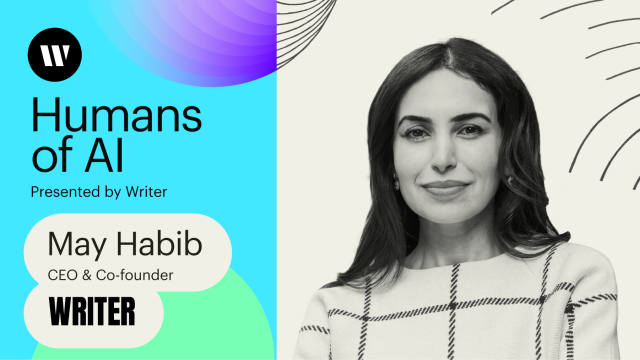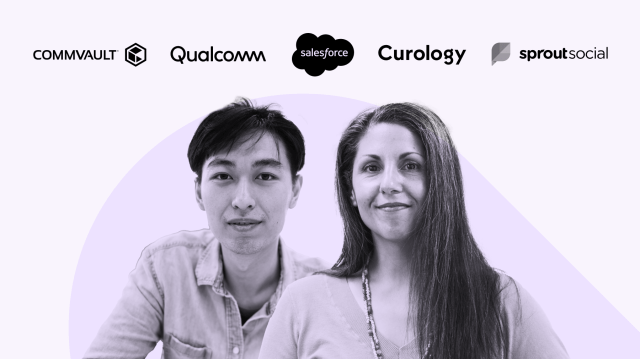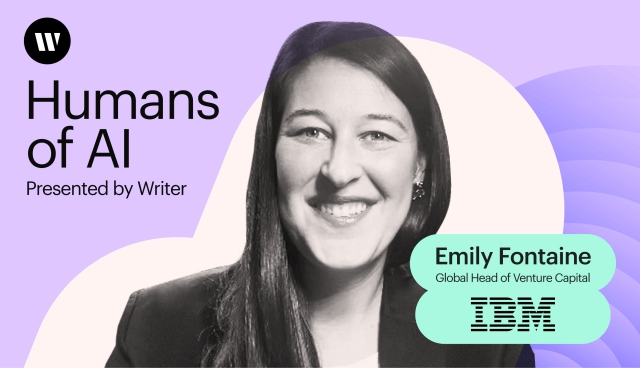Humans in the loop
– 9 min read
Innovation in focus: A conversation with May Habib and Gavin Patterson

Visionary leadership is important to any organization’s success. But in the age of AI, it’s the difference between nirvana levels of ROI and fragmented, tension-filled teams.
In this episode of Humans of AI, WRITER CEO May Habib sits down with Gavin Patterson, former chief revenue officer and president of Salesforce, at WRITER’s exclusive AI Leaders Forum in London. Beyond his corporate roles, Gavin is also an advisor and board member for several companies — including WRITER, Wix, Ocado, Kraken, and Cahoot, and he chairs the charity Alzheimer’s Research UK.
Gavin explores the dual emotions of excitement and fear that CEOs and executives experience as they navigate the disruptive wave of AI. He shares his philosophy on identifying transformative opportunities in the face of rapid innovation and how to properly implement org-wide change management.
- CEOs are experiencing a mix of excitement and fear regarding generative AI. Its potential for productivity gains and new revenue streams, along with concerns about job displacement, regulation, and cybersecurity, drive this.
- Successful AI integration is a leadership challenge that requires a CEO-led, cross-functional action committee to ensure alignment and broad adoption.
- Addressing employee concerns about job displacement, data security, and ethical issues is crucial for building trust and support for AI initiatives.
- External exposure is vital for CEOs to stay informed and drive meaningful change.
- A people-first approach to AI adoption can help employees adapt and embrace the technology.
A mixture of excitement and fear surround AI
Gavin is both excited and wary about the current state of generative AI. He sees it as the biggest technology trend in the past 20 years, even bigger than the creation of the internet. The potential to radically change the market and business models, along with new revenue and growth opportunities, is energizing. But he’s also worried about the displacement of employees, regulatory issues, and ethical issues.
“That’s a real concern… how difficult it is to drive adoption when you’re asking, essentially, turkeys, to vote for Christmas in some way,” Gavin says. “They’re concerned about regulation and ethics. And that it’s gonna be deployed in an appropriate way. And that is in many cases, slowing down the deployment.”
The pace of innovation in generative AI is at least 10 to 100 times faster than previous technology waves. Gavin was at a recent advisory board meeting where he was blown away by the potential of self-evolving models to radically simplify business operations in a cost-effective way. This is a big change compared to just over two years ago when very few companies were actively using AI.
“I think it’s usually attributed to Bill Gates, but there’s this quote about technology adoption and change where nothing seems to really change over a sort of one-to-two-year period,” Gavin says. “But somewhere between two and 10, there’s radical change, and if you look back in time, you can really see that, yeah, the first couple of years of the iPhone versus the next eight or the first couple of years of mobile versus the next eight. So we are in the two-to eight-year range now.”
Top-level leadership is vital in AI change management
Grappling with this revolutionary technology requires strong leadership, and as Gavin notes, it’s a fundamental challenge rather than just a technological one. He stresses that AI is an amazing tool, but its best results come when it’s applied to businesses in a traditional way.
“By that, I mean focusing on the fundamentals,” Gavin explains. “How is it driving new revenue? How is it driving cost transformation? How is it improving? Customer experience. How do I align it with business strategy, in other words, rooting it into what you are trying to do with the business.”
When a change affects the entire business, it needs to be cross-functional. And, according to Gavin, led by the CEO.
“There are certain decisions that only come together at the CEO level, and it’s actually more efficient that you’ve got a cadence, and you’ve got a regular meeting to get those decisions done,” he says. “I think it also symbolizes importance to everybody in the organization. As a CEO, what you say is important, but what you do, how you behave, what you prioritize is what people respond to.”
Gavin also stresses the importance of integrating AI adoption into everyone’s learning, just as security training and Excel are part of basic onboarding. He likened it to the new reading and writing in the modern business landscape.
How to get buy-in from the CEO
It’s difficult to continuously pick up new things and stay up-to-date. Gavin notes that this becomes harder each year, especially for CEOs in their 40s or older and even more so for those in their 60s or 70s. He thinks it’s important to create a safe way for CEOs and the board to ask more basic-level questions they may be too afraid to ask in front of others.
“I would also create the tools for them to play with,” Gavin suggests. “The more you can create apps that align with the business strategy, align with revenue and customer experience and productivity. The more that you can demonstrate actually it can help them do some of the things in their day-to-day lives faster, better creating more time to do other things, the more I think they’ll get on board.”
It’s important to tackle concerns head-on with the CEO. Don’t shy away from conversations about security, ethics, or displacement. Talk about what happens with training data and the opportunities to upskill the team.
“There’s always a shortage of people with basic tech skills,” Gavin says. “It was touched on this morning, creating a pathway into future careers. That allows not just the CEO to feel better about what he or she’s doing, but actually everybody within the organization to realize that there is a way forward.”
Our 2025 enterprise AI adoption report reveals a large disconnect between workers and employers. 41% of Millennial and Gen Z employees admit to sabotaging their company’s AI strategy due to fears of job displacement. Don’t leave your team in the dark — deploy AI program management to help them evolve.
Salesforce, for example, created an online learning experience that directs employees to become proficient in using Salesforce. This leads to more confidence and new job opportunities, benefitting the entire organization.
The public versus private CEO involvement gap
Public company CEOs, burdened by board meetings, earnings calls, and private investor meetings, often find their schedules too packed to fully engage. It’s usually private companies — of all sizes — that are getting deeply involved and making a real impact with the kind of collaboration needed for AI adoption.
Gavin has worked for private and public companies, and his critical advice to executives is to simplify your diary.
“It’s almost like the boiled frog syndrome, sort of the incremental change you don’t notice until it suddenly kills you. It’s the same a little bit with your diary,” he explains. “It just gets clogged up with meetings that don’t actually need to happen or don’t necessarily need you to be part of it. So being absolutely brutal about prioritization so that you free up time to drive transformation through the business.”
He also points out that a crisis can be a powerful motivator — whether from a competitive action, an activist investor, or even a deadline. And while internal motivation and drive are important, Gavin cautions that’s not the only thing CEOs can focus on because “99% of the innovation that is going to affect your business and your market is happening outside of your business.”
How to find the right AI partner
For Gavin, one of the biggest challenges after leaving executive life was staying relevant and continuing to learn. The constant flow of information and insights in the C-suite is hard to replicate, and being part of WRITER’s journey was a privilege that kept him engaged and up-to-date.
“Every meeting I’ve had since with the [WRITER] team — the energy, the speed, the sense that you’re a part of something that is gonna radically change the way people go about their lives and their work is intoxicating,” he says.
Executives are used to being bombarded with vendor pitches that often claim to be groundbreaking. Gavin notes that standing out requires more than bold claims and a slick presentation. It’s about building the right relationships, finding key people within the organization, and fostering trust over time.
“I always judged my relationships with business partners ultimately on a sort of key question,” Gavin says. “Which is, ‘Would they ever recommend or have they ever recommended something to me to do, which is against their own personal interests?’”
And there’s no time to waste when it comes to AI.
“I think it’s very easy to procrastinate or wait for somebody else to go first,” Gavin says. “I have no doubt in my own mind this is gonna be the biggest change that happens in our — certainly will be in my — career. I’m certain of that… It is that important. It’s that big. And this isn’t one to sort of procrastinate on.”
As we navigate the exhilarating yet daunting landscape of AI, it’s clear that true success comes from how AI is integrated into the human fabric of our organizations. Gavin’s insights underscore the importance of leadership, collaboration, and a people-first approach in ensuring that AI serves as a catalyst for growth and innovation — rather than a source of fear and displacement.
Want to hear more stories from the humans working at the crossroads of business and generative AI? Subscribe to Humans of AI wherever you listen to podcasts.


